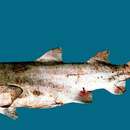Diagnostic Description
provided by Fishbase
A shark with a short, pointed snout, small eyes, protruding spike-like teeth and small, equal-sized dorsal and anal fins; 1st dorsal fin closer to pelvic than to pectoral fins (Ref. 5578). Caudal fin with a pronounced subterminal notch and a short ventral lobe (Ref. 13575). Pale brown or grey, paler below, with dark spots that appear faded in adults; fins plain (Ref. 6586).
- Recorder
- Cristina V. Garilao
Life Cycle
provided by Fishbase
Exhibit ovoviparity (aplacental viviparity), with embryos feeding on other ova produced by the mother (oophagy) after the yolk sac is absorbed, then cannibalize siblings (adelphophagy) (Ref. 50449). Distinct pairing with embrace (Ref. 205). Eggs leave the ovaries, and while in transit in the oviducts are fertilized and enclosed in groups of 16 to 23 in egg cases. However, at some time between fertilization and birth only two (Ref. 5578, 6586) embryos of its group prevails, possibly by devouring its rivals, and proceeds to eat fertilized eggs and smaller potential siblings in utero until birth. According to Springer (1948) (Ref. 39565), it is evident that this species sends forth into the world not only large, well-developed, and even experienced young but may send them forth with a full stomach. The yolk sac is resorbed at a small size, less than 17 cm, and the umbilical scar may be lost. Gestation period may be from 8 to 9 months long. Size at birth 100 cm (Ref. 6586).Pratt (2001) (Ref. 49562) relates Gordon's (1993) (Ref. 51113) detailed account of the mating behavior of the sand tiger sharks as follows: "mating activities began when the two male C. taurus, having become reluctant to feed, increased their swimming speed, accompanied by clasper flexion and eventual interest in their female tank mates...aggressive displays such as snapping and stalking became frequent, mostly toward species of smaller Carcharhinus in the tank. The males did not become interested in the female until she slowed, moved to the sand area and started cupping her pelvic fins. The two males then became competitive toward each other, circling and tailing, until the alpha male forced the beta male out of the sand area. The female bit the male prior to copulation. She exhibited shielding behavior for several days and then resumed cupping and flaring. The female gradually changed her swimming position and began displaying the submissive behavior. The alpha male swam in increasingly larger circles and began splaying its claspers, then approached the female and exhibited tailing and nosing. Copulation occurred as the male bit into the right flank and trailing edge of the pectoral fin of the female. The male swam side by side with the female, copulating with the right clasper for one to two minutes. After copulation, the male showed little interest in the female." In captivity, males show aggression toward other species after copulation (Ref. 51113, 49562). Females avoid patrolling males by 'shielding' with pelvics close to the substrate (Ref. 51113, 49562). However, female acceptance of future male partner is indicated by a show of 'submissive' body, 'cupping' and 'flaring' of pelvic fins (Ref. 51113, 49562).
Migration
provided by Fishbase
Oceanodromous. Migrating within oceans typically between spawning and different feeding areas, as tunas do. Migrations should be cyclical and predictable and cover more than 100 km.
- Recorder
- Kent E. Carpenter
Morphology
provided by Fishbase
Dorsal spines (total): 0; Dorsal soft rays (total): 0; Analspines: 0; Analsoft rays: 0
- Recorder
- Cristina V. Garilao
Trophic Strategy
provided by Fishbase
A carnivore (Ref. 9137).
Biology
provided by Fishbase
A common littoral shark found inshore from the surf zone and in shallow bays to at least 191 m on the outer continental shelves (Ref. 13568). Often on or near the bottom but also occurs in midwater or at the surface (Ref. 247). Only shark known to gulp and store air in its stomach to maintain neutral buoyancy while swimming (Ref. 13568). Found singly or in small to large schools (Ref. 247). Feeds on bony fishes, small sharks, rays, squids, crabs, and lobsters (Ref. 5578). Ovoviviparous, embryos feeding on yolk sac and other ova produced by the mother as well as other siblings in the womb (uterine cannibalism) (Ref. 50449). Usually gives birth to 2 pups after a 9-12 months gestation period (Ref.58048). A migratory species in parts of its range, particularly in its northern and southern extremities where pronounced poleward migration occur in the summer and equatorial movements in autumn and winter (Ref. 247). Usually inoffensive and not aggressive when not provoked (Ref. 247) but has known to bite swimmers and be aggressive towards divers with speared fish (Ref. 6586). Utilized for fresh, frozen, smoked and dried for human consumption (Ref. 247); also for fishmeal, liver oil, fins, and hides for leather (Ref. 13568). Flesh highly appreciated in Japan (Ref. 36731).
- Recorder
- Kent E. Carpenter
Importance
provided by Fishbase
fisheries: commercial; gamefish: yes
- Recorder
- Kent E. Carpenter

